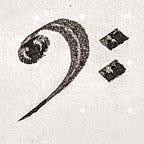Writing chord charts
Are you a singer or a lead instrument player, and would like to perform with a band? Write a chord chart for them!
Charts need to be written with a thick, black line. Lighting is often poor on the bandstand and charts written with a pencil are unreadable. A 1.0mm gel pen is best.
Name of the tune goes on top
Meter, tempo, style, bar lines
The number 130 below means that there are 130 quarter notes / beats per minute. Drummers often know immediately what tempo to play in, based on that number alone. You can measure tempos online, using the space button to tap to beat of a song. Don’t be uncertain about your tempos, decide the tempo for each tune and stick to it.
Indicate the musical style.
Put four bars in every line. This allows for easy and quick orientation around the chart.
Chords
Chords are the most obvious part of the chart. It’s important to place them correctly in bars. Based on where they are placed, the band will know when to change chords.
Check the chords with an instrument. If you took the chords from the Internet, there are chances the chords are imprecise or wrong. You also need to make sure that the chords are in your key.
Arrangement elements, breaks
Here are some conventions we use to make the structure of the tune obvious (e.g. AABA), and to show where breaks happen.
If a part of a song needs to be played twice, ||: we mark the part this way :||. If it’s repeated more than once, we annotate it with a number “×3”.
Breaks are common, you can hear them for example in the recording of Route 66 at 0:43. Write rhythms using notes without staves, pitches are not needed.
You can expect the band to play as on a driving licence exam — unless told otherwise they will drive straight ahead at a constant speed.
Ending
A typical pattern is to end the song by playing from the head, and jump to an ending section — coda. The place to start from is “segno”, which looks like a joined S and %. Starting from the segno, the band plays, until it comes across the coda sign, which looks like a Celtic cross. Then they jump to the coda.
In the example above, the band will play Gm7, then play the break at C7, and instead of continuing to F7, will skip to the last two lines, which begin with Am7|D7.
What not to write down
Even though we are writing a chart for a song, lyrics and melody are in most cases not necessary. Ideally the band members would know the melody, but they don’t play it, so it’s not required, and writing it in the chart could cause confusion.
Done!
See the finished chart in a higher resolution.
The chart should contain only what’s necessary, as little as possible ‒ but not less! What to write down and what to omit, will come with practice. After a rehearsal, ask your musicians if your charts were well written, was everything clear and is there anything that can be corrected.
It’s useful to see some examples. The best are in The Real Book series. They are examples of jazz pieces but the way they are written isn’t specific to jazz and can just as well be used for any other kind of popular music.
